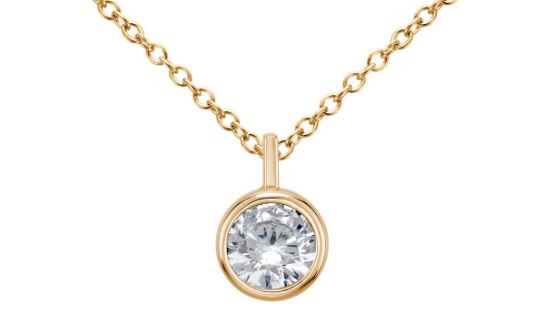We are reader-supported. Buying through any red colored link on our site may earn us commissions. Learn More.
Although most of the emails we get are about engagement rings, we’re also often contacted by readers looking for help with diamond necklaces, bracelets and other jewelry.
Earlier, a reader contacted us asking for help buying a floating diamond necklace with a budget of $1,000 to $1,200. They asked if it was best to find a loose diamond, then have it set inside a specific pendant.
This reader’s idea is perfect. You’ll almost always get a higher quality diamond at a lower price by choosing a loose diamond, then pairing it with a beautiful setting using a jewelry builder tool like those offered by Blue Nile and James Allen.
Here’s the reader’s original email:
“Looking for floating diamond necklace with a budget of $1000 to $1200. Is it best to find a diamond and then have it put in a setting of that necklace? Should I call Blue Nile?”
This reader ended up purchasing a beautiful diamond of just under 0.50 carats from James Allen, then getting it set in a wire basket solitaire pendant.
Sometimes, a short email like this from a reader presents a great opportunity to give advice on a bigger topic — in this case, buying a diamond pendant for a budget of around $1,000.
How to Buy a Diamond Pendant for $1,000
Diamond pendants make for incredible gifts, especially for your significant other. They’re usually given as a symbol of love, making them ideal for anniversaries, birthdays or other dates that are special to you and your loved one.

With an approximately $1,000 budget like this reader, you’ll be able to buy a beautiful 0.40 to 0.50 carat diamond, then set it in a solitaire pendant.
When it comes to buying a diamond pendant, the same rules apply as for diamond engagement rings:
- Choose a diamond with excellent or ideal cut quality
- Select a shape based on your personal preferences
- Ensure the diamond is eye-clean and looks white in relation to its setting
- Pick the largest carat weight that’s within your budget
1. Let’s start from the beginning with cut quality. Cut is by far the most important of the diamond 4 Cs, as it has a direct impact on a diamond’s light performance and brilliance. Well cut diamonds reflect lots of light, giving them an eye-catching appearance and the illusion of a larger carat weight.
Due to its light performance, a well cut small diamond will look more impressive than a far larger diamond that has a poor cut grade, which will appear dull and lifeless.
For a round diamond, we recommend limiting your search to diamonds with a cut quality grade of excellent (if graded by the GIA) or ideal (if graded by the AGS).
We also recommend reviewing our guide to diamond cut so that you can check each diamond’s cut parameters, such as its depth, width and table size.
When it comes to shape, there’s no “best” shape for a diamond pendant. Choose a shape that matches your preferences and suits the wearer’s style. For pendants, the most popular choice (and almost always the “safest” option) is a round brilliant cut diamond.
2. When it comes to diamond clarity, there’s no reason to aim for perfection. Instead, it’s better to choose a diamond that’s eye-clean (meaning it doesn’t have any visible inclusions).
Eye-cleanliness is particularly important for a diamond that will be set inside a pendant, as it will be directly in people’s line of sight.
For a round, princess cut or heart-shaped diamond in the 0.50 carat range, a clarity grade in the VS2 to SI1 range will almost always ensure the diamond looks eye-clean.
Other shapes, such as the oval cut, cushion cut, marquise cut, radiant cut and pear shape, tend to hide inclusions better than others, meaning you should be able to safely drop down to the SI1 to SI2 range.
For step cut diamonds, such as an emerald cut, baguette or Asscher cut, it’s always best to pick a stone with a VS2 grade or better. This is because, as the GIA states, the long step cuts of these shapes “do not hide imperfections well.” Inclusions are often particularly visible in low clarity grades, making the VS2 grade a good limit on how low you can go before you get into territory where diamonds that fail the eye-clean test become common.
As always, you should inspect the diamond using the 360° photos provided by James Allen and Blue Nile to verify that it’s eye-clean. Use the tips in our eye-clean diamonds guide to identify a stone that’s free of visible inclusions, or feel free to contact us for help with your search.
3. For color, it’s always best to choose a diamond that appears white in relation to its setting. For a round brilliant cut diamond, this generally means a color grade between H and J for a white gold or platinum pendant, or K to M for a yellow or rose gold pendant.
You can find specific color grade recommendations for different diamond shapes and metals in our guide to diamond color.
With these guidelines in mind, you can find some stunning diamonds and pendants for a budget of approximately $1,000.
For example, this 0.46 carat, J color, VS2 clarity diamond and this 14K yellow gold solitaire four prong pendant are available together for just under $1,000.
This 0.46 carat, I color, VS2 clarity round cut diamond with a 14K white gold petite bail pendant from Blue Nile is also beautiful and available for just over $1,000.
Our Recommendation
A diamond pendant can be an incredible gift, whether it’s for a birthday, anniversary or any other occasion. With a budget of approximately $1,000, you’ll be able to select a diamond in the 0.4 to 0.5 carat range and have it set in an elegant solitaire setting.
As always, the usual rules of buying a diamond apply, from prioritizing cut to choosing color and clarity grades that make the diamond appear colorless and eye-clean.
Our guide to buying a diamond pendant goes into more detail about this process, including the best chains, clasps and chain lengths for this type of jewelry.
Need help choosing the right diamond? Feel free to contact us like this reader did to talk to our expert team and get help finding the best diamond and pendant for your tastes and budget.

- No questions asked returns within 30 days of shipment. James Allen will send you a paid shipping label to return the ring.
- Lifetime Warranty
- Free International Shipping
- Free prong tightening, repolishing, rhodium plating and cleaning every 6 months
- Provide insurance appraisals
- One free resizing within 60 days of purchase
- Free ring inscriptions
- Best-in-class high quality imagery of all diamonds in stock
- 24/7 Customer Service
- Best-in-class packaging


- No questions asked returns within 30 days of shipment. Blue Nile will send you a paid shipping label to return the ring.
- Lifetime Warranty
- Free Shipping
- Free prong tightening, repolishing, rhodium plating and cleaning every 6 months
- Provide insurance appraisal
- One free resizing within the first year of purchase
- High quality images of about half of their diamonds
- 24/7 Customer Service
- 100% credit towards future upgrades (must be at least double in value)
- Best in class fulfillment

- 10 Engagement Ring Styles You Should Consider if You’re Obsessed with Royal Families
- Ask a Diamond Pro: Buying a Diamond Online vs. Locally in Los Angeles
- Ask a Diamond Pro: Asscher Cut Diamond for a Three-Stone Ring
- Rose Gold Engagement Rings: Timeless and Unique
- Ask a Diamond Pro: How to Buy an Oval Cut Diamond


